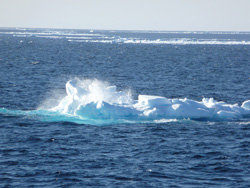Steve Lambert, WHOIAugust 25, 2012With Mooring B recovered we planned to redeploy it the next day. Saturday morning, however, we were greeted with dense fog and a lot of swell making for rather difficult work. With this much roll of the ship it is very unsafe to hoist equipment out of the hold up onto the forward deck. It also creates problems lowering the two ton anchor, wire, and delicate instruments over the side. As the ship sways back and forth the wire will have a lot of strain then unload and can reload quickly. While the winch, block, crane, and other tackle can handle the load it is much better working in calm seas. Working on deck in fog also requires a little more awareness of the fact that, if you should happen to go over the side, it will be really difficult to keep you in sight. Everyone aboard has commented on the lack of ice at this location; there shouldn't be swell here and it should be covered in ice! We have seen little to no ice this entire trip and the increase in fog has slowed us down. The ship can make 17-18 knots but we will normally do about 10 in fog. Since we are already behind schedule the slow transit times just make things more frustrating. To make up some of the time several sampling stations have had to be cut from the list and at times the CTD isn't sent to full depth. This is not good for our science mission. As the fog lifted after breakfast the sunshine showed us exactly what we had to deal with: ice hung from the rigging and the swell was increasing as the wind gained to nearly 40 knots. While the LSSL is a wonderful ice breaker, ice breakers aren't known for handling sea state terribly well. Her hull doesn't resemble the deep V of perhaps a destroyer but more the rounded shape of a cargo ship and it doesn't take a lot of swell to make her rock bath and forth. After a meeting of the scientists and officers it has been decided to head north to look for ice. We are hoping to find a nice large, thick floe to deploy a set of instruments. Since we are not yet at the ice minimum for the year the larger the floe the better as some melting is expected in the coming weeks. The problem, however, is that this project concentrates on the gyre - the Beaufort Sea is known for a large essentially rotating body of water and instruments deployed there tend to last a little longer. If we go north we are likely to wander out of the gyre and the instruments could drift toward land too quickly shortening their useful life. Last updated: October 7, 2019 | |||||||||||||||||
Copyright ©2007 Woods Hole Oceanographic Institution, All Rights Reserved, Privacy Policy. | |||||||||||||||||



